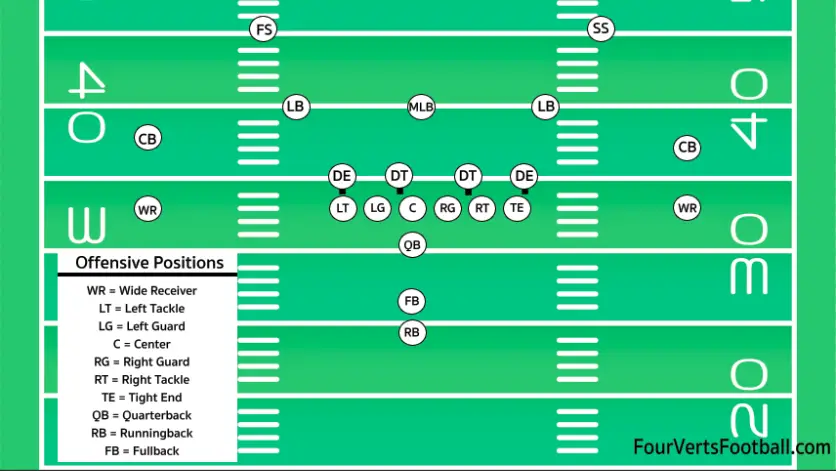Football can be a fairly complex sport and with all the positions between offense and defense things can get confusing. Luckily this guide is on hand to break down all the offensive positions in football.
Offensive positions in football include quarterback, wide receiver(2), tight end, runningback, fullback, offensive tackle(2), offensive guard(2), center.
Quarterback

As you likely already know the quarterback is the most important position in football.
On every play, the quarterback is going to have the ball in his hands. The primary purpose of this player is to throw the ball to his receivers and hand it off to his running back.
On passing plays the quarterback is going to have the ball passed to him from the center to start the play.
The quarterback will then back up into the pocket, this is a small area of the field in which the quarterback will be protected by the offensive line.
The quarterback will then look downfield in an attempt to find a player to throw the ball to. He will already know where his receivers are heading on the play and will already have a receiver in mind to throw to.
If no receivers are open the quarterback may choose to advance the ball by carrying it himself.
On rushing plays, the quarterback will have the responsibility of handing the ball to the running back.
Again the quarterback will know where the runningback is headed and will have an area called the mesh point. This is where the running back and quarterback will meet to hand off the ball.
The quarterback is also going to be the player responsible for leading the team. The offense will huddle after each play and the quarterback will speak with his teammates and tell them what play they are running.
At the professional level, the quarterback will have a radio in his helmet which allows the coaching staff to communicate the play with him.
The quarterback will also be responsible for the cadence on each play. The cadence is the verbal signals such as “White 80” or “hut hut” that let the team know when the ball is going to be snapped.
On top of their on-the-field responsibilities, quarterbacks are also expected to be leaders in the locker room and off the field. This can make this position incredibly difficult as not many athletes are cut out for all these responsibilities.
Offensive Weapons
Though the quarterback deserved its own category the rest of the offensive positions are going to be organized by groups. The next offensive position group we have the are the offensive weapons.
This category of offensive players includes any player on the offense that primarily catches or carries the football.
Receivers
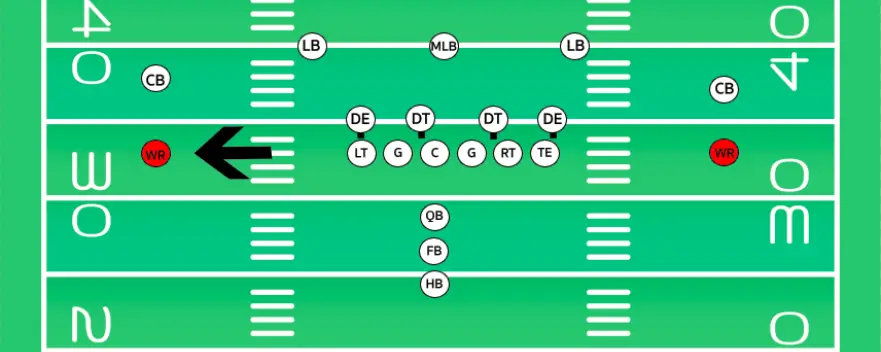
Receivers in football are primarily responsible for catching the football. On any given offensive passing play this position will run in a pattern called a route which is meant to get them open for a pass.
On a passing play, each receiver will have a predetermined route they will run on the play.
There are two kinds of receivers in football, wide receivers and slot receivers. Wide receivers line up near the sideline on either end of the field.
Slot receivers line up between the sideline and the rest of the offensive players in an area called the slot.
Wide receivers tend to be larger than slot receivers and are more likely to catch long passes. Slot receivers tend to be small and quick and primarily catch passes that travel under fifteen yards.
On rushing plays receivers do not play a very big role. They will usually block the cornerback that lines up in front of them.
Since most receivers line up far away from the rest of the offense they are usually not very close to the ball carrier.
This means their blocking on rushing players is often inconsequential.
In most formations, there are going to be two or three receivers on the field. That being said some offenses can use as many as four receivers or as little as zero.
Tight Ends
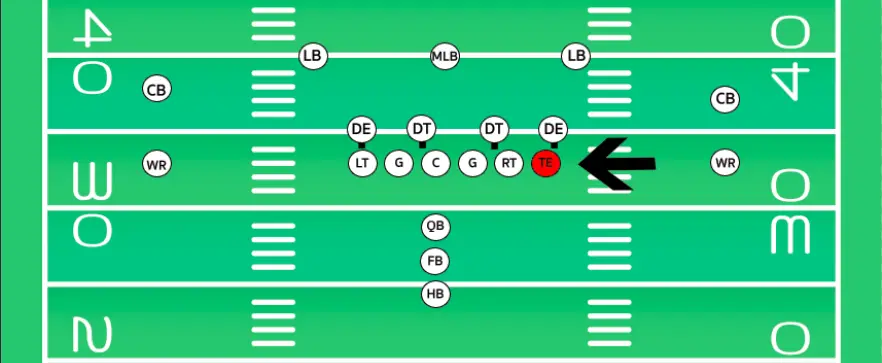
The tight end position in football is a sort of hybrid between an offensive lineman and a receiver.
These players line up right on the end of the offensive line beside the tackle.
On passing plays tight ends are going to play the same as wide receivers. These players are going to be assigned a route to run.
The tight end will try and get separation from the defender covering them and ultimately catch a pass from the quarterback.
On rushing plays, the tight end is going to play an important role in blocking. Since there are five offensive linemen the side the tight end lines up on is going to have more players.
This is referred to as the “strong side” since there are more players on this side of the formation the offense is more likely to run the ball in this direction.
This means the tight end is often going to be blocking defenders on the side of the ball field the ball is run towards. This can make run-blocking tight ends a valuable piece to an offense.
Since this position is required to block and catch passes they must have large frames but also remain athletic.
Runningbacks

Running back is the position on the offense which is most often handed the ball by the quarterback. These players are often one of the fastest and most elusive players on the offense.
On rushing plays, this position is going to line up in the backfield. Once the ball is snapped the runningback will meet the quarterback in the backfield and have the ball handed to him.
The running back will have a predetermined hole he will run through in the offensive line.
The offensive line will know which hole the runningback is heading through and will attempt to block players to create a large opening.
On passing plays the runningback may receive passes out of the backfield or they may help in pass protection.
Similar to a receiver runningbacks can run routes in order to get open for the quarterback. But since the running back starts the play in the backfield these routes are usually quite short.
If the quarterback feels the defenders are going to be coming his way the runningback will be tasked with pass protection.
On these plays, the runningback will wait in the backfield for defenders to come. Once a defender breaks through the offensive line the runningback will step up and block them.
Fullbacks
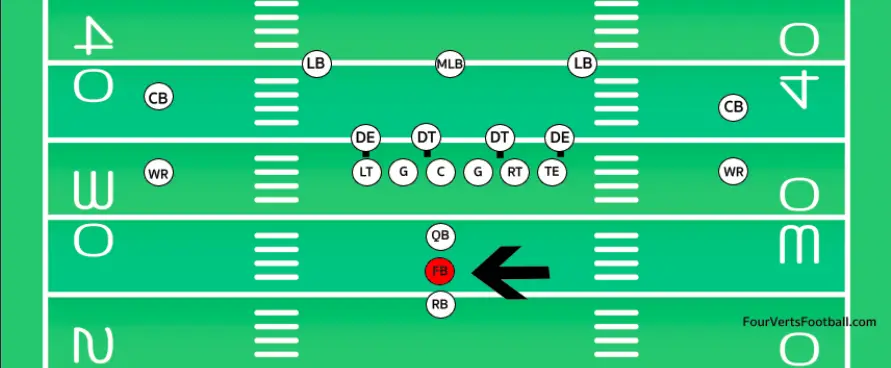
One position that has become much less popular in recent years is the fullback. The fullback position is similar to a running back though they tend to be slower and stronger.
Fullbacks can carry the ball and catch passes but they primarily serve as blockers. These players will line up in the backfield similar to a runningback.
When blocking on rushing plays fullbacks will often act as a lead blocker. This means they will run through the hole ahead of the running back and take on whichever defender is waiting on the other end.
The increase in passing in the NFL has made fullbacks much less common. Now that players are faster and more agile players like fullbacks are not as effective on the field.
Offensive Line
The final position group we are going to cover is the offensive line. The offensive line features five players, a center, two guards, and two tackles.
Some formations may feature an extra offensive lineman in specific situations but there are almost always five o-lineman on the field.
Offensive Tackles
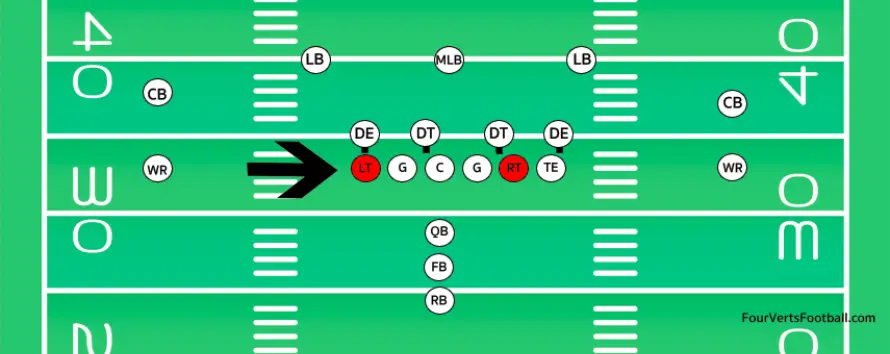
Arguably the most important position on the offensive line is the offensive tackle. These players line up on either end of the offensive line and are primarily responsible for stopping edge rushers.
The defense usually puts their best pass rushers at the end of the defensive line. This means tackles will often have to go one on one against their opponent’s top edge rusher.
This makes the tackle position incredibly important, especially the one protecting the quarterback’s blindside.
If a quarterback is right-handed they are going to have their back turned to the left side of the defensive line during the play. This puts a lot of pressure on the left tackle to protect that side of line.
If a player is able to reach the quarterback’s blindside it often results in a big hit. For this reason, offensive tackles protecting the quarterback’s blindside are one of the highest-paid positions in football.
On rushing plays offensive tackles will usually block the defensive ends. Oftentimes the tackle will set the edge keeping the defensive end from getting into the pocket.
Though generally speaking offensive tackles are more desired for their abilities in pass protection over run blocking.
Tackles in football are referred to as left tackles and right tackles based on which side they line up on. These positions are denoted with the acronyms LT and RT.
Offensive guards
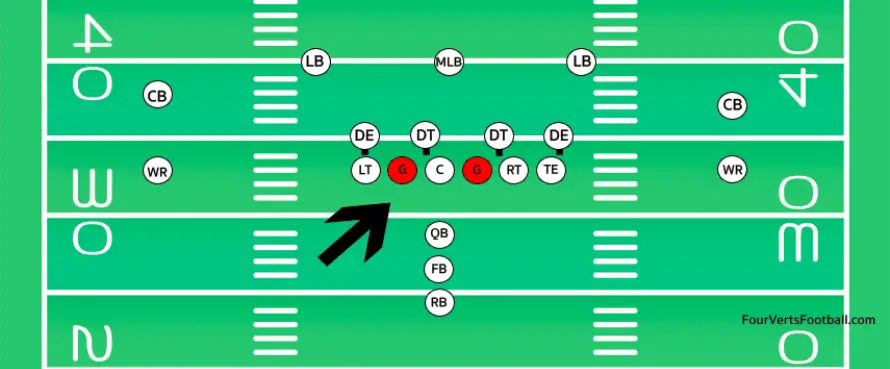
Offensive guards are interior offensive linemen that play an important role in passing and rushing plays.
On passing plays guards are going to be in pass protection. They will look to keep the quarterback’s pocket clean by stopping interior lineman.
Since these players line up in the interior of the offensive line they will usually take on defensive tackles.
Oftentimes guards will double team a defensive tackle along with the center. If guards allow a defender to get into the pocket through the middle of the offensive line it will often result in a sack.
On rushing plays guards will block defensive tackles and linebackers in order to create space for the ball carrier.
On some plays, the guard will pull which means they will leave the offensive line and head downfield to block for the running back.
Many guards excel at run blocking and can make a huge difference in a runningbacks ability to move the ball downfield.
Center

Aside from the quarterback, the center is the only player that touches the ball on every play. The center must be sure to accurately snap the ball to the quarterback each play.
Once the snap is completed the center plays a very similar role to an offensive guard. On passing plays, these players will slowly move backwards keeping any defenders from reaching the quarterback.
On rushing plays the center will look to move the defensive tackles in order to open a hole for the ball carrier.
Similar to a guard centers will pull and block downfield on some occasions though this is relatively rare.
Conclusion
Remembering all the positions in football can be difficult but it is not as complicated as it seems.
Of the eleven starting positions five are going to be on the offensive line. These players include two guards, two tackles, and a center.
When it comes to skill positions there are almost always going to be a combination of wide receivers, tight ends, and running backs on the field.
Generally, there will be several receivers with two lining up out wide and often one in the slot.
Then of course there is the quarterback that leads the offense. A standard NFL offensive would include 1 QB, 3 WR, 1 TE, 1 RB, 2 OTs, 2 OGs, and 1 C.
That is all on offensive positions in football, to learn more see our guide to all the defensive positions in football.
